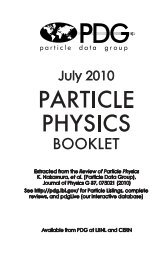30. Passage of particles through matter 1 - Particle Data Group
30. Passage of particles through matter 1 - Particle Data Group
30. Passage of particles through matter 1 - Particle Data Group
You also want an ePaper? Increase the reach of your titles
YUMPU automatically turns print PDFs into web optimized ePapers that Google loves.
<strong>30.</strong> <strong>Passage</strong> <strong>of</strong> <strong>particles</strong> <strong>through</strong> <strong>matter</strong> 35<br />
whose opening half-angle η is given by<br />
� �<br />
d<br />
cotη = (ω tan θc)<br />
dω ω0<br />
�<br />
= tan θc + β 2 ω n(ω) dn<br />
�<br />
cot θc<br />
dω<br />
ω0<br />
, (<strong>30.</strong>42)<br />
where ω0 is the central value <strong>of</strong> the small frequency range under consideration.<br />
(See Fig. <strong>30.</strong>26.) This cone has a opening half-angle η, and, unless the medium<br />
is non-dispersive (dn/dω = 0), θc + η �= 90 0 . The Cherenkov wavefront ‘sideslips’<br />
along with the particle [79]. This effect may have timing implications for ring<br />
imaging Cherenkov counters [80], but it is probably unimportant for most<br />
applications.<br />
The number <strong>of</strong> photons produced per unit path length <strong>of</strong> a particle with charge<br />
ze and per unit energy interval <strong>of</strong> the photons is<br />
or, equivalently,<br />
d 2 N<br />
dEdx<br />
= αz2<br />
�c sin2 θc = α2 z 2<br />
re mec 2<br />
�<br />
1 −<br />
≈ 370 sin 2 θc(E) eV −1 cm −1<br />
d 2 N<br />
dxdλ<br />
= 2παz2<br />
λ 2<br />
�<br />
1 −<br />
1<br />
β2n2 �<br />
(λ)<br />
1<br />
β2n2 �<br />
(E)<br />
(z = 1) , (<strong>30.</strong>43)<br />
. (<strong>30.</strong>44)<br />
The index <strong>of</strong> refraction n is a function <strong>of</strong> photon energy E = �ω, as is the<br />
sensitivity <strong>of</strong> the transducer used to detect the light. For practical use, Eq. (<strong>30.</strong>43)<br />
must be multiplied by the the transducer response function and integrated over<br />
the region for which β n(ω) > 1. Further details are given in the discussion <strong>of</strong><br />
Cherenkov detectors in the <strong>Particle</strong> Detectors section (Sec. 31 <strong>of</strong> this Review).<br />
When two <strong>particles</strong> are close together (lateral separation < ∼ 1 wavelength),<br />
the electromagnetic fields from the <strong>particles</strong> may add coherently, affecting the<br />
Cherenkov radiation. Because <strong>of</strong> their opposite charges, the radiation from<br />
an e + e − pair at close separation is suppressed compared to two independent<br />
leptons [81].<br />
<strong>30.</strong>7.2. Coherent radio Cherenkov radiation :<br />
Coherent Cherenkov radiation is produced by many charged <strong>particles</strong> with<br />
a non-zero net charge moving <strong>through</strong> <strong>matter</strong> on an approximately common<br />
“wavefront”—for example, the electrons and positrons in a high-energy electromagnetic<br />
cascade. The signals can be visible above backgrounds for shower<br />
energies as low as 10 17 eV; see Sec. 32.3.2 for more details. The phenomenon is<br />
called the Askaryan effect [82]. Near the end <strong>of</strong> a shower, when typical particle<br />
energies are below Ec (but still relativistic), a charge imbalance develops. The<br />
photons can Compton-scatter atomic electrons, and positrons can annihilate<br />
June 18, 2012 16:19







